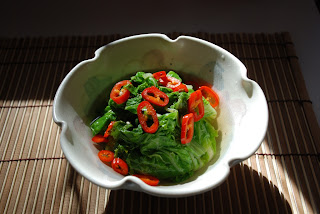The Japanese food experience
One of the most distinctive characteristics of authentic Japanese food is the simplicity, freshness and clean taste of dishes with flavourings designed to complement with delicacy rather than dominance. To Japanese tastes, 'mouth-feel' or texture is extremely important as well and some of these textures can be pretty strange to the unfamiliar. (I can remember my first taste of Yama-imo Mountain Yam at the Hirano-ya restaurant in Arashiyama, Kyoto; a distinctive combination of sliminess and crunchiness.) However, one who like me who has grown up with western taste habits and familiar - strong - flavours can adjust to and appreciate the key differences reflected in the Japanese style of cooking and food preparation. Just come with an open mind and be motivated by the healthy change and particularly with vegetarian ingredients and dishes.The story of Koya-dofu 高野豆腐
Freeze-dried tofu from Mount Koya-san is worth trying even if you don't fall in love with the texture. A quality product should still taste fresh with a slightly stronger (but clean) nuttier flavour of soya beans than fresh tofu. This is a story of a trip to Koya-san last year and the famous Koya-dofu 高野豆腐 . The recipe for simmered Koya-dofu with shitake is one of my favourites.Koya-dofu is the most popular souvenir for visitors to Koya-san. It is believed to have been first produced by the 8th patriarch of Shingon Buddhism, Kukai - also known as Kobo-dashi. You can visit the memorial of Kobo-daishi in Koya-san. A night-time visit walking through the ancient cemetery and avenue of cedars is an amazing experience.
Koya-dofu is an important part of Buddhist temple food [ Shojin Ryori 精進料理 ] which you can enjoy at an overnight stay at a temple. We were very well looked after at Ekoin.
 |
| Tourists in Koya-san queuing for Koya-dofu |
 |
| Two brands of Koya-dofu: Juzuya Shirobei on the right. |
Koya-dofu to shitake no nimono [高野豆腐としいたけの煮物] : Simmered freeze-dried tofu with shiitake mushrooms
Ingredients (for two people as part of a meal):
4 blocks of Koya-dofu
8 medium-sized dried shiitake mushrooms
200 ml of dashi stock (konbu or katsuobushi)
50 ml of sake
3 tbs mirin
3 tbs light Shoyu
Snow peas
Mitsuba or kinome
Step 1:
Soak the shiitake mushrooms in hot water (enough to cover) for about an hour. Trim hard stems and simmer in about 400 ml of fresh water for 15-20 minutes. Set aside and save the stock.
Step 2:
In a glass bowl, set the tofu pieces and very gently add boiling water to cover. Don't pour the water directly on top of the tofu because they may break. Soak for about an hour then very gently rinse in two to three changes of water to cleanse the fine residue from the tofu. Cut the tofu into bite-sized pieces around 2-3 cms.
Step 3:
Heat the dashi, 100 ml of the shiitake stock, mirin and shoyu in a pot to simmering point and add the tofu and the shiitake. Simmer for around 15 minutes and take off the heat.
Serve at room temperature with the trimmed snow peas or (in summer) cool.











